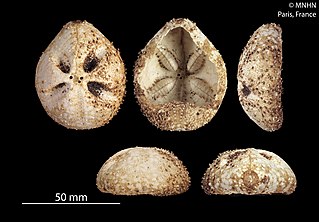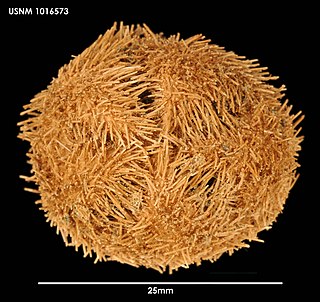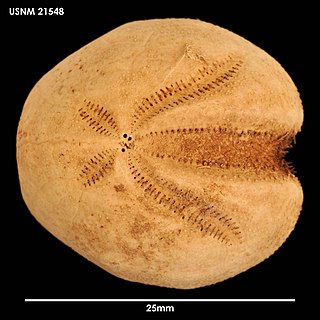
Coelopleurus is an extant genus of echinoids with fossil records dating back to the Eocene, with remains found in Europe and North America.

Temnopleuridea is an infraorder of sea urchins in the order Camarodonta. They are distinguished from other sea urchins by the presence of large fused plates on top of the feeding lantern. The test is usually sculpted to some degree, and has perforated tubercles.

The Camarodonta are an order of globular sea urchins in the class Echinoidea. The fossil record shows that camarodonts have been in existence since the Lower Cretaceous.
Agassizia excentrica is a species of sea urchin of the family Prenasteridae. The species was first scientifically described in 1869 by Alexander Agassiz.
Amphipneustes bifidus is a species of sea urchin. Their armor is covered with spines. It is placed in the genus Amphipneustes and lives in the sea. Amphipneustes bifidus was first scientifically described in 1950 by Ole Mortensen, a Danish scientist.

Amphipneustes brevisternalis is a species of sea urchin. Their armour is covered with spines. It is placed in the genus Amphipneustes and lives in the sea. Amphipneustes brevisternalis was first scientifically described in 1926 by Koehler.

Amphipneustes davidi is a species of sea urchin. Their armour is covered with spines. It is placed in the genus Amphipneustes and lives in the sea. Amphipneustes davidi was first scientifically described in 2010 by Madon-Senez.

Amphipneustes koehleri is a species of sea urchin. Their armour is covered with spines. It is placed in the genus Amphipneustes and lives in the sea. Amphipneustes koehleri was first scientifically described in 1905 by Ole Mortensen.
Amphipneustes mironovi is a species of sea urchin. Their armour is covered with spines. It is placed in the genus Amphipneustes and lives in the sea. Amphipneustes mironovi was first scientifically described in 1991 by Markov.
Amphipneustes rostratus is a species of sea urchin. Their armour is covered with spines. It is placed in the genus Amphipneustes and lives in the sea. Amphipneustes rostratus was first scientifically described in 1926 by Koehler.

Amphipneustes similis is a species of sea urchin. Their armour is covered with spines. It is placed in the genus Amphipneustes and lives in the sea. Amphipneustes similis was first scientifically described in 1936 by Ole Mortensen, Danish zoologist.
Amphipneustes tumescens is a species of sea urchin. Their armour is covered with spines. It is placed in the genus Amphipneustes and lives in the sea. Amphipneustes tumescens was first scientifically described in 1926 by Koehler.

Holasteroida is an order of irregular sea urchins.

Aporocidaris milleri is a species of sea urchin of the family Ctenocidaridae. Their armour is covered with spines. It is placed in the genus Aporocidaris and lives in the sea. Aporocidaris milleri was first scientifically described in 1898 by Alexander Emanuel Agassiz.

Araeosoma coriaceum is a species of sea urchin of the family Echinothuriidae. Its armour is covered with spines. It is placed in the genus Araeosoma and lives in the sea. A. coriaceum was first scientifically described in 1879 by Alexander Emanuel Agassiz, an American scientist.

Brisaster moseleyi is a species of sea urchins of the family Schizasteridae. Their armour is covered with spines. Brisaster moseleyi was first scientifically described in 1881 by Alexander Emanuel Agassiz.

Chaetodiadema is a genus of sea urchins of the Family Diadematidae. Their armour is covered with spines.

Araeosoma is a genus of deep-sea sea urchins in the family Echinothuriidae.

Dermechinus is a genus of sea urchin in the family Echinidae found in deep water in the southern Indian, Pacific and Atlantic Oceans. It is monotypic, with Dermechinus horridus, sometimes called the cactus urchin, being the only species.
Schizasteridae is a family of echinoderms belonging to the order Spatangoida.














